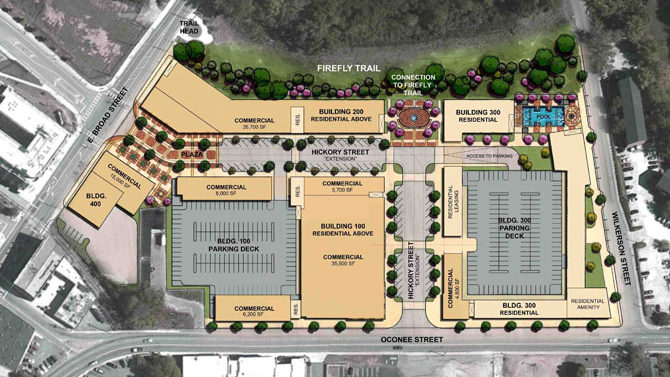Athens residents will finally (finally!) get a chance to formally weigh in on Selig Enterprises’ controversial downtown development.
A year-and-a-half after the proposal was made public, Selig Enteprise filed plans with Athens-Clarke County earlier this month for a massive mixed use development on the Armstrong & Dobbs property between East Broad and Oconee streets. And, yes, it will require Athens-Clarke County Commission approval—but only for a small portion of the development.
Part of the development would include ground-floor residential units, which are illegal downtown—ACC requires commercial space on the ground floor in the downtown area—so Selig will need a special use permit from the commission.
The county planning commission is scheduled to make a recommendation on the request at its Thursday, June 6 meeting at 7 p.m. in the planning department’s Dougherty Street auditorium. (Public comment will be taken.) It’s only supposed to consider the narrow issue of whether ground floor residential should be allowed.
“That’s what staff’s review is going to be held to, and that’s what the planning commission is supposed to focus on, not the big picture,” ACC planner Gavin Hassemer said.
The “big picture” decision will be left to the ACC Commission at its Tuesday, July 2 meeting, should the planning commission issue a recommendation June 6, a time when many locals are likely to be out of town on vacation. However, even if the commission turns down the special use application, Selig could still build the development with retail on the ground floor.
At the same time, Selig is also going through an alternative compliance process to get around minimum window requirements along Wikerson Street and part of East Broad Street because the topography and lack of space for on-street parking make ground-floor storefronts with windows impossible, said Jo Ann Chitty, senior vice president for the Atlanta-based firm. A public art mural could cover a blank wall along East Broad.
“The way the topo goes with the road, and the way the buildings have to be constructed, it’s almost like a retaining wall,” Hassemer said.
The alternative compliance process was put into place as part of downtown design guidelines approved in 2006 to give developers more flexibility to meet the guidelines. “It gives them a chance to give and take,” Hassemer said. The ACC Planning Commission has final approval on that aspect of the plans.
The requests prove that Protect Downtown Athens—the Patterson Hood-soundtracked activist group formed to fight, or at least positively influence the development—was right in saying that it wasn’t a “done deal” and didn’t meet the local zoning code. Co-founder Tony Eubanks wasn’t ready to comment on it quite yet. “We appreciate Selig’s efforts to address some of our concerns with the previous plan,” he said. “It’s a significant change from the original proposal and given the potential impact, we’re studying the plans to issue a careful analysis as soon as possible.”
The development is still gargantuan: half a million square feet, including a Walmart’s worth of commercial space (though divided up into smaller stores) and 375 apartments. But “the design has improved, thanks to public input that Mayor Denson sought to thwart,” said Russell Edwards, part of the People for a Better Athens movement that fought the development when Walmart, which has since backed out, was supposed to be the anchor.
As promised, the development’s big box anchor is much smaller: 35,500 square feet, as opposed to 90,000 in the original 2011 proposal, which was never filed. The anchor has also been moved from the corner of Wilkerson and Oconee streets to the middle of the development, near the Hickory Street extension that will connect Oconee Street to the Multimodal Center.
Another common complaint was that the development turned its back on the future Firefly Trail. Retailers and apartments will now line the rails-to-trails project on the east side of the development. There will be bike racks, a tire pump and a colonnade with outdoor tables along Firefly Trail, too, Selig Senior Vice President Jo Ann Chitty said.
The development will draw an estimated 5,900 car trips per day, according to Selig’s 460-page traffic study. To accommodate those cars, the company plans to add a left turn lane to southbound Oconee Street, as well as a traffic signal at the intersection with Hickory Street Extension. That street will connect Oconee Street and the University of Georgia campus to the Multimodal Center. It will, according to Chitty, be “beyond what’s called for in the (ACC) transportation plan,” and will be able to accommodate buses and include sidewalks, bike lanes and a pedestrian plaza at the East Broad Street entrance.
All those drivers will need places to park, and so will the nearly 1,000 people who will live there, if all the bedrooms are filled. The development will include about 1,400 parking spaces in two decks that are mostly hidden by apartments and stores.
“We anticipate that the primary residents will be students,” Chitty said. “That’s the market.” Some of them could be converted to condos down the road, she added.
Additional student housing was needed to obtain financing and attract retailers to the development, she said. “The more residential there is downtown, the better it’s going to be for the businesses, the retailers and the restaurants.”
Selig says it is seeking “a mix of national, regional and local retailers that will be a good fit for Athens and this space. “No leases have been signed yet, but there is strong interest in this project.”
Like what you just read? Support Flagpole by making a donation today. Every dollar you give helps fund our ongoing mission to provide Athens with quality, independent journalism.










